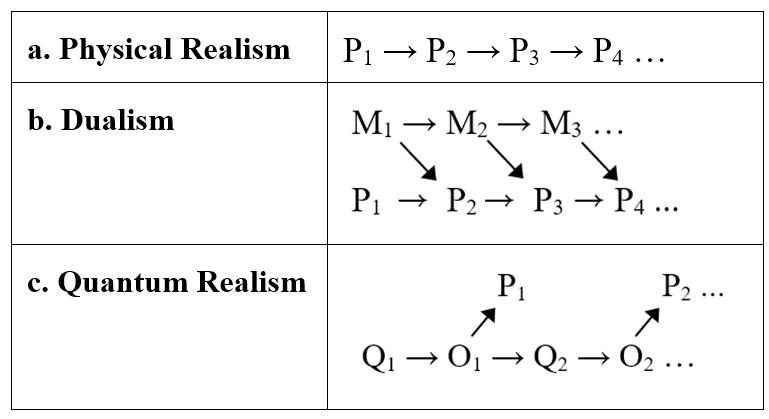In 1637, Descartes argued that scientific physicalism and religious idealism are both true, because mind was a substance outside space just as matter was a substance within it. However, two centuries later, Laplace rejected this, arguing that matter alone determined the universe:
“We may regard the present state of the universe as the effect of its past and the cause of its future. An intellect which at a certain moment would know all forces that set nature in motion, and all positions of all items of which nature is composed, if this intellect were also vast enough to submit these data to analysis, it would embrace in a single formula the movements of the greatest bodies of the universe and those of the tiniest atom; for such an intellect nothing would be uncertain and the future just like the past would be present before its eyes.” Laplace, in (Truscott & Emory, 1951) p4.
That physical laws explained everything challenged mind-matter dualism by claiming that science not only didn’t need religion, it was better off without it. The case was that all physical events have a physical cause, so the universe is causally closed. It is a causal chain with no gaps, like a tube of balls, where pushing one end makes a ball pop out the other end, with no mind or soul needed to make it happen. If all physical facts come from other physical facts, there is no room for mental causes. Causal closure implies that if mind has a physical cause, it is also physical and so not mind, and if not, it can’t have a physical effect (Kim, 1999). Causal closure implies that a non-physical mind can’t affect physical events.
Supporters of dualism sought to demonstrate non-physical causes by paranormal events, like the ability to mentally move objects (telekinesis) or see the unseeable (extra-sensory perception), but attempts to replicate mental powers haven’t been definitive (Kelly at al., 2007).
Then just as physicalism was replacing dualism, a new theory, quantum mechanics, concluded that no physical event is 100% certain. In the Stern-Gerlach experiment, silver atoms in a magnetic field go up or down based on a spin that is perfectly random. We can’t pre-sort the atoms into those going up or down because they are initially identical, and the spin that moves them up or down in the magnetic field is decided when they observe it, not before. Quantum theory says this happens when the atoms are in the field, just as where a photon hits a screen is decided at the screen. In a mechanical universe, the physical past should entirely define the physical future, but it isn’t so in our universe.
When quantum entities interact, they choose their physical future from what is possible and this unpredictability is part of our universe. Quantum theory rejects the idea that the universe is completely physically predictable, and the evidence agrees, so it can’t be a big machine.
In quantum theory, when a quantum wave is observed, it randomly actualizes a physical event from one of its lawful possibilities and obliterates the rest. This stops the quantum wave expanding endlessly by restarting it. An observer outside the quantum system ends the chain of quantum events, but there is by definition nothing outside a closed physical universe to do this.
An endless physical chain with no gaps has no way to select one link to be an observation, so it has no way to allow observation or choice. In contrast quantum realism accepts both because it accepts quantum theory entirely. Figure 6.2 compares the reality options.

Figure 6.2 compares the reality options:
a. In physical realism, a series of physical events (P) lawfully cause each other with no gaps, so there is no observation or choice.
b. In dualism, a series of physical events (P) and mental events (M) affect physical events, so there is observation and choice.
c. In quantum realism, quantum events (Q) cause observations (O) of physical events (P), so there is both observation and choice. Note that many quantum events produce one physical event.
In Figure 6.2a, each set of physical events causes the next, with no choice or observation possible, so there can be no evolution or observation, yet we know that both occur.
In Figure 6.2b, two causal chains, mental (M) and physical (P), affect not only their realm but also the other, but that mind events cause physical events is both unproven and illogical.
In Figure 6.2c, physical reality (P) arises when quantum waves (Q) interact to allow observation (O), as quantum theory says. Every quantum collapse is then an observation choice.
If quantum waves spread, interact and collapse to give the observations we call the physical world. Quantum realism has no gaps for physical causes just as physical realism had no gaps for mental causes. A physical event is an observed result, not a cause, so it causes nothing. In this view, physical reality is an epiphenomenon that, like a train whistle, appears but doesn’t affect the quantum engine driving reality.
If quantum reality creates physical reality, physical laws derive entirely from quantum laws. Physical causality is based on quantum causality, so it is correlation not causality. When a quantum entity picks a physical event from the possibilities it has discovered, it redefines the future timeline. Quantum theory works when physical realism doesn’t because it recognizes that quantum events cause the future, not physical events.